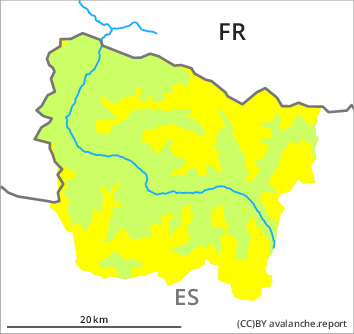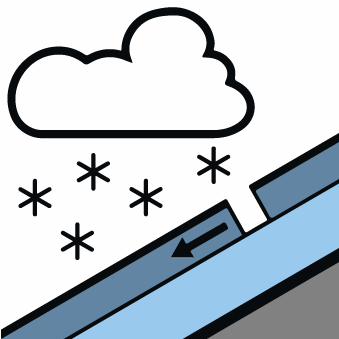
Danger level

2000m
Avalanche Problem

New snow

2000m


Wind-drifted snow

2300m


Dry snow slides and avalanches and moist snow slides are likely to occur. Old wind slabs require caution.
As a consequence of the new snow more frequent dry and moist snow slides are to be expected as the day progresses, but they will be mostly small. The avalanche prone locations are to be found in all aspects above approximately 2000 m. In addition soft wind slabs will form in particular adjacent to ridgelines and at high altitudes. The fresh wind slabs can be released easily, but they will be small in most cases.
The old wind slabs can still be released in some cases in particular on very steep shady slopes and at high altitudes and in high Alpine regions. The avalanche prone locations are to be found especially adjacent to ridgelines and in gullies and bowls. In particular in areas where the snow cover is rather shallow Explanation: "these" may only stand for "these avalanches" can be triggered in the faceted old snow and reach medium size.
Backcountry touring and other off-piste activities call for meticulous route selection. The avalanche prone locations are barely recognisable because of the poor visibility.
The old wind slabs can still be released in some cases in particular on very steep shady slopes and at high altitudes and in high Alpine regions. The avalanche prone locations are to be found especially adjacent to ridgelines and in gullies and bowls. In particular in areas where the snow cover is rather shallow Explanation: "these" may only stand for "these avalanches" can be triggered in the faceted old snow and reach medium size.
Backcountry touring and other off-piste activities call for meticulous route selection. The avalanche prone locations are barely recognisable because of the poor visibility.
Snowpack
>
Thursday: Some snow has fallen since the late morning. Friday: 10 to 15 cm of snow, and even more in some localities, will fall until the early morning above approximately 2000 m. The wind will be light to moderate adjacent to ridgelines. The northeasterly wind will transport the new snow.
The avalanche conditions above the tree line are to some extent treacherous. The old wind slabs are lying on weak layers on wind-protected shady slopes and at intermediate and high altitudes. Released avalanches and field observations confirm the unfavourable bonding of the snowpack.
Above approximately 2000 m there are 100 to 200 cm of snow. At high altitudes and in high Alpine regions snow depths vary greatly, depending on the infuence of the wind.
The avalanche conditions above the tree line are to some extent treacherous. The old wind slabs are lying on weak layers on wind-protected shady slopes and at intermediate and high altitudes. Released avalanches and field observations confirm the unfavourable bonding of the snowpack.
Above approximately 2000 m there are 100 to 200 cm of snow. At high altitudes and in high Alpine regions snow depths vary greatly, depending on the infuence of the wind.
Tendency
Saturday: Gradual decrease in danger of dry avalanches as the snowfall eases. Significant increase in danger of moist avalanches as a consequence of warming during the day and solar radiation. In particular very steep shady slopes and transitions from a shallow to a deep snowpack: Weak layers in the old snowpack necessitate caution.